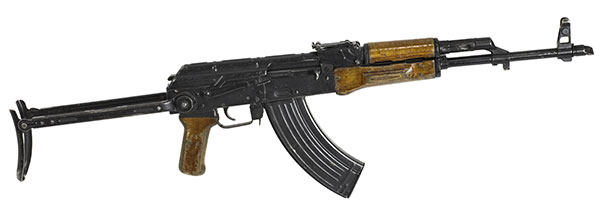By Lar Joye
Three large arms plants were developed in the 1920s by the new Soviet government, as it attempted to modernise the old Czar’s army in the wake of the Revolution. These modern plants would eventually produce the world’s most famous firearm, the AK-47 assault rifle. There are an estimated 80 million of these rifles in the world, making it the most used weapon since 1947, responsible for the deaths of more people than nuclear bombs. It is as iconic as the Coke bottle, Rubik’s Cube, Sony Walkman or Apple iPhone. Journalist Michael Hodges has identified three eras of the AK-47: the expansion of the Soviet Union in Eastern Europe in the 1950s; the Third World revolutions in the 1960s and 1970s; and, since 2001, its association with Osama bin Laden and the wars in Iraq, Afghanistan, Libya and Syria. Therefore on Western television it is the gun of criminals and terrorists, while in other parts of the world it is the weapon of liberation and is even represented on the national flag of Mozambique.
The A stands for avtomat (automatic), K stands for the inventor’s surname, Kalashnikov, and 47 indicates the year in which it was designed. It is the size of a sub-machine gun but is called an assault rifle, which means that, although short, it has the accuracy of a rifle over 600m and its 30-round magazine can be fired in seconds at close quarters. It has eight moving parts, is very easy to use, easy to clean and cheap to make. It was designed by Sergeant Mikhail Kalashnikov, a former tank commander who had fought in what is called in Russia today the ‘Great Patriotic War’, in which communism defeated fascism with the capture of Berlin on 30 April 1945. He would claim many years later: ‘I invented a weapon to save the Motherland, to save the state from fascism’. It was quickly accepted by the Soviet Army in 1949, was enhanced in 1959 as the AK-‘M’ (modern) and in 1974 as the AK-74.

In Ireland the AK-47 was associated with the Provisional IRA and Ulster Volunteer Force (UVF) in the 1980s and 1990s. The Provisionals’ AK-47s were provided mainly by Colonel Gaddafi of Libya in a series of shipments through Wexford from 1985 to 1987, in what is regarded as the greatest blunder by Irish and British intelligence services of the Troubles. Working on the principle that my enemy’s enemy is my friend, Libya provided over 150 tons of AK-47s, AK-74s, Taurus pistols, rocket-launchers, surface-to-air missiles and Semtex high explosive. The UVF acquired their rifles at the same time through a circuitous route from Israel via South Africa. In 2013 a decommissioned AK-47 in the National Museum of Ireland’s collection was selected as the 100th object in Fintan O’Toole’s A history of Ireland in 100 objects, representing the ending of the Troubles and the 1998 Peace Agreement.
Lar Joye is curator of military history at the National Museum of Ireland (Decorative Arts and History).
